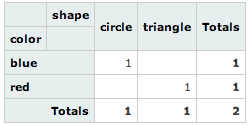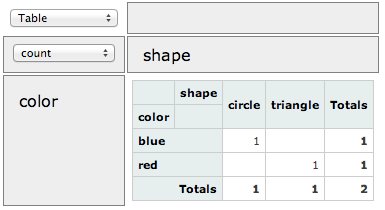-
Notifications
You must be signed in to change notification settings - Fork 1.1k
Parameters
There are two main functions defined in pivot.coffee: pivot() and pivotUI() (see below), both implemented as jQuery plugins, as well as a bunch of helpers and templates accessible via $.pivotUtilities.
Despite the fact that this is described as a Javascript library, it's actually written in CoffeeScript. You can compile pivot.coffee into pivot.js with coffee -c pivot.coffee or you can use the precompiled JS file from the examples directory.
Once you've loaded jQuery and pivot.js, this code (demo):
$("#output").pivot(
[
{color: "blue", shape: "circle"},
{color: "red", shape: "triangle"}
],
{
rows: ["color"],
cols: ["shape"]
}
);
appends this table to $("#output") (the default, overridable behaviour is to populate the table cells with counts):
A slight change to this code (calling pivotUI() instead of pivot()) yields the same table with a drag'n'drop UI around it, so long as you've imported jQueryUI (demo). Note that pivot() and pivotUI() take different parameters in general, even though in this case we can pass the same parameters to both.
$("#output").pivotUI(
[
{color: "blue", shape: "circle"},
{color: "red", shape: "triangle"}
],
{
rows: ["color"],
cols: ["shape"]
}
);
##pivot(input [,options])
pivot will inject an HTML table into the object onto which it is called, which will summarize input according to options.
input is an array of objects, an array of arrays, a function or a jQuery object referencing a table (see documentation and examples: array, function, table).
options is an object with the following keys:
-
rows: array of attribute names to use as rows, defaults to[] -
cols: array of attribute names for use as columns, defaults to[] -
aggregator: constructor for an object which will aggregate results per cell, defaults tocount()(see documentation) -
renderer: function to generate output from pivot data structure (defaults to simple table, see documentation) -
derivedAttributes: object to define derived attributes, defaults to{}(see documentation) -
filter: function called on each record, returnsfalseif the record is to be excluded from the input before rendering ortrueotherwise, (defaults to returningtruefor all records) -
sorters: function which is called with an attribute name and can return a function which can be used as an argument toArray.sortfor output purposes. If no function is returned, the default sorting mechanism is a built-in "natural sort" implementation. Useful for sorting attributes like month names, see example. -
rendererOptions: object passed through to renderer as options -
localeStrings: locale-specific strings for error messages
##pivotUI(input [,options [,overwrite [,locale]]])
pivotUI will essentiall draw a UI and then call pivot. It will call pivot every time the UI is changed via a drag'n'drop or an aggregator selection. The options object lets you set up the UI itself in terms of what visualization aggregators and effects are offered, and it lets you prepopulate the various options as well.
input is an array of objects, an array of arrays, a function or a jQuery object referencing a table (see documentation and examples: array, function, table).
options is an object with the following keys:
-
renderers: dictionary of rendering functions, defaulting with various table renderers (see documentation) -
aggregators: dictionary of generators for aggregation functions in dropdown, defaulting to common aggregators (see documentation) -
rows: array of strings, attribute names to prepopulate in row area, default is[] -
cols: array of strings, attribute names to prepopulate in cols area, default is[] -
vals: array of strings, attribute names to prepopulate in vals area, default is[](gets passed to aggregator generating function) -
aggregatorName: string, aggregator to prepopulate in dropdown (key toaggregatorsobject), default is first key inaggregators -
rendererName: string, renderer to prepopulate in radio button (key torenderersobject), default is first key inrenderers -
derivedAttributes: object, defines derived attributes, default is{}(see documentation) -
filter: function called on each record, returnsfalseif the record is to be excluded from the input before rendering ortrueotherwise, (defaults to returningtruefor all records) -
exclusions: object, defaults to{}, keys are attribute names and values are arrays of attribute values which denote records to exclude from rendering (used to prepopulate the filter menus that appear on double-click) -
hiddenAttributes: array of strings, defaults to[], contains attribute names to omit from the UI -
sorters: function which is called with an attribute name and can return a function which can be used as an argument toArray.sortfor output purposes. If no function is returned, the default sorting mechanism is a built-in "natural sort" implementation. Useful for sorting attributes like month names, see example. -
onRefresh: function, called upon renderer refresh with an object representing the current UI settings -
menuLimit: integer, defaults to 50, maximum number of values to list in the double-click menu -
autoSortUnusedAttrs: boolean, defaults to false, controls whether or not unused attributes are kept sorted in the UI -
unusedAttrsVertical: boolean or numeric, defaults to 85, controls whether or not unused attributes are shown vertically instead of the default which is horizontally. true means always vertical, false means always horizontal. If set to a number (as is the default) then if the attributes' names' combined length in characters exceeds the number then the attributes will be shown vertically. -
rendererOptions: object, defaults to null, passed through to renderer as options -
localeStrings: object, defaults to English strings (seelocaleparameter below), locale-specific strings for UI display
overwrite is a boolean defaulting to false which controls what happens if this function is called repeatedly on the same element. If set to true, the options object overwrites the current state of the UI. If set to false, only the input data set changes, and the state of the UI remains the same, unless this is the first call, at which point the UI will be set to the options.
locale is a string defaulting to en which controls the default locale for things like number formatting and error messages. Regardless of this setting, you can still override the default aggregators (which control number formatting) and error message strings. If this is set to something other than en you will have to load a locale-specific 'language pack' which creates this locale object before calling pivotUI(). See Localization for more info.

